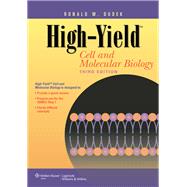High-Yield Cell and Molecular Biology, Third Edition provides the essential information needed for USMLE Step 1 review and course study. It covers current cell and molecular biology techniques and principles with a clinical focus-what a physician needs to know to understand, diagnose, and treat human disease. Molecular biology is often taught within various courses such as biochemistry, microbiology, and histology; thus, a consolidated review book in molecular biology is especially helpful in preparing for the USMLE Step 1.
This edition had been streamlined to remove content covered in other High Yield books such as histopathology and microbiology. Images have been placed closer to the appropriate text. New figures include DNA melting curve and flow cytometry.
Features:
-NEW! edited and streamlined to remove content covered in other High Yield books (e.g., Histopathology, Microbiology)
-NEW! improved layout of art and text to place fugures closer to the appropriate text
-NEW! new figures to Cover DNA melting curve and flow ctyometry; covers current molecular biology techniques and principles with a clinical focus - what a physician needs to know to diagnose, understabd and treat human disease; defines the line between molecular biolgy and genetics
This book and High-Yield Genetics by the same author have been written as a complementary pair & includes cell biology, but no basic traditional histology.
"Where will the time needed to teach a molecular biology course be found' I suspect what will happen is that many of the "traditional" courses will extend their discussion of various topics down to the molecular biology level. This approach will work, but it will in effect make molecular biology somewhat disjointed. The student will learn some molecular biology in a Biochemistry course, some in a Microbiology course, and some in a Histology course, etc. The problem this presents for students reviewing for USMLE Step 1 is that molecular biology information will be scattered among various course notes"-Provided by publisher








